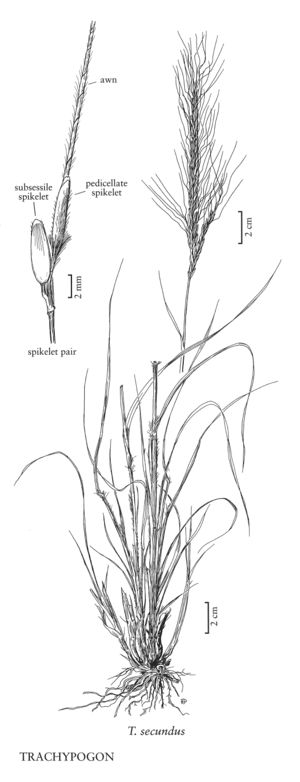Difference between revisions of "Trachypogon secundus"
FNA>Volume Importer |
imported>Volume Importer |
||
| (8 intermediate revisions by 2 users not shown) | |||
| Line 16: | Line 16: | ||
-->{{Treatment/Body | -->{{Treatment/Body | ||
| − | |discussion=<p>Trachypogon secundus is found in sandy prairies, woodlands, rocky hills, and canyons, in well-drained soils at 500-2000m. Statements about is range are difficult to make because of disagreement as to whether northern plants, such as those found in the Flora region, belong to the same species as those found elsewhere.</p><!-- | + | |discussion=<p><i>Trachypogon secundus</i> is found in sandy prairies, woodlands, rocky hills, and canyons, in well-drained soils at 500-2000m. Statements about is range are difficult to make because of disagreement as to whether northern plants, such as those found in the Flora region, belong to the same species as those found elsewhere.</p><!-- |
| − | --><p>Trachypogon secundus resembles Heteropogon, but differs in the longer, non-disarticulating inflorescence and shorter, pale awns. It rates as fairly good fodder when green, but is seldom abundant enough to be an important forage grass.</p> | + | --><p><i>Trachypogon secundus</i> resembles <i>Heteropogon</i>, but differs in the longer, non-disarticulating inflorescence and shorter, pale awns. It rates as fairly good fodder when green, but is seldom abundant enough to be an important forage grass.</p> |
|tables= | |tables= | ||
|references= | |references= | ||
| Line 26: | Line 26: | ||
-->{{#Taxon: | -->{{#Taxon: | ||
name=Trachypogon secundus | name=Trachypogon secundus | ||
| − | |||
|authority=(J. Presl) Scribn. | |authority=(J. Presl) Scribn. | ||
|rank=species | |rank=species | ||
| Line 33: | Line 32: | ||
|basionyms= | |basionyms= | ||
|family=Poaceae | |family=Poaceae | ||
| + | |illustrator=Linda A. Vorobik;Hana Pazdírková | ||
| + | |illustration copyright=Utah State University | ||
|reference=None | |reference=None | ||
|publication title= | |publication title= | ||
|publication year= | |publication year= | ||
|special status= | |special status= | ||
| − | |source xml=https:// | + | |source xml=https://bitbucket.org/aafc-mbb/fna-data-curation/src/200273ad09963decb8fc72550212de541d86569d/coarse_grained_fna_xml/V25/V25_1528.xml |
|subfamily=Poaceae subfam. Panicoideae | |subfamily=Poaceae subfam. Panicoideae | ||
|tribe=Poaceae tribe Andropogoneae | |tribe=Poaceae tribe Andropogoneae | ||
Latest revision as of 18:57, 11 May 2021
Plants perennial. Culms 60-120 cm, erect; nodes appressed-hirsute. Sheaths sparsely appressed-pilose; ligules 2-5 mm, stiff, acute; blades usually 12-35 cm long, 3-8 mm wide, with a broad midrib. Racemes 10-18 cm, the internodes glabrous. Pedicellate spikelets 6-8 mm; glumes pilose; awns 4-6 cm, pilose below, with 1-2 mm hairs, nearly glabrous distally; anthers 4-5 mm, orange. 2n = 20.
Discussion
Trachypogon secundus is found in sandy prairies, woodlands, rocky hills, and canyons, in well-drained soils at 500-2000m. Statements about is range are difficult to make because of disagreement as to whether northern plants, such as those found in the Flora region, belong to the same species as those found elsewhere.
Trachypogon secundus resembles Heteropogon, but differs in the longer, non-disarticulating inflorescence and shorter, pale awns. It rates as fairly good fodder when green, but is seldom abundant enough to be an important forage grass.
Selected References
None.
